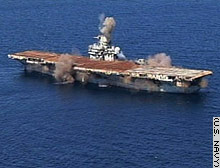Saturday, May 27, 2006
Underwater Combat? What in the World....

I recently came across a blog that examined some of the iconography associated with the scuba diving in the 1960s. Drawing on childhood memories, the feature’s author Gene Gable, notes “the '60s was a great decade for good guys vs. bad guys. Cowboys and Indians were still viable entertainment, and the post-war interest in army heroes hadn't faded. If you were a young boy looking for something a little more contemporary, there was the emerging field of spy adventure or space exploration, all inspired by popular television shows. Though I never wanted to play cowboys and Indians, and my heart wasn't in the army thing, I went through a "Man from Uncle" spy phase and had a short fantasy period where I was a character on "My Favorite Martian." But it took re-runs of the TV show "Sea Hunt" to really catch my attention. From then on, I was fighting off sharks, saving trapped divers from certain doom, and slicing through the air hoses of bad guys on the bottom of the sea floor. All from the safety of the backyard swimming pool…”
Gable observes “for some reason, scuba diving and knife fighting went together from the beginning, though I doubt many underwater fights ever really took place. If you could sneak up behind your victim and cut his air hose, there was nothing he could do but head for the surface. Sadly, modern equipment did away with the original two-hose regulators, so knife fights went out and spear guns came in as the preferred underwater weapon. The (accompanying) images are from Sea Hunt Comics (top) in 1960 and Frogman comics (bottom) in 1962. One of the challenges for artists unfamiliar with the intricacies of the sport was to realistically depict situations when, in most cases, they had never been under water themselves.”
OK, I admit it. I was similarly inspired by Sea Hunt. Like Gable, I experienced the show in syndication but unlike the author, I had no backyard pool which magically converted to the ocean realm. I had to be satisfied with the Milwaukee County Swimming Pool at Hoyt Park, where the harried lifeguards would warn us with deep, megaphone-magnified voices to knock off our above and underwater wrestling inspired by Sea Hunt. And yes, as a certified diver, I did not put away the foolishness of my youth, taking part in staged underwater fights with some of my more adventurous, curious, or just plain bored dive buddies on the bottom of pools and the sand flats of Goleta Beach. By the way, grappling and rolling around the urchin covered rock reefs of California is not recommended unless one is trying to understand the experience of underwater fighting with a porcupine. And playing underwater hockey at UCSB sometimes resembled the underwater fight scene from Thunderball.
Outside of an occasional juvenile role play, do underwater combat skills have any applicability? I only used it once, years ago. My friend Brandon was trying to get a shot of a wolf eel pair on the bottom off Quattra Island on the Campbell River in British Columbia. A boatload of divers from another vessel descended on the spot before Brandon could get his shot framed. When they charged forward to evict him from the spot, I ran interference using my underwater hockey skills, body checking one of the divers into his buddy, causing both of them to back off. Brandon got his shot and we promptly exited the area. Decades ago, I learned underwater self defense techniques as a lifeguard and a divemaster against panicked swimmers, but that aspect of guard training has really fallen into disfavor among many lifeguard instructors (although not the lifeguards who seem to still like to practice it). I guess other aquatic combat techniques might find some application in water polo where most of the fouls occur under the water out of the sight of the officials. I recall a UCSB student I worked out with at the State Street Boxing Club in Santa Barbara telling me that he was teaching the kids on the water polo team at San Marcos High School some of the dirty tricks, just as his student coach had taught him when he was a high school freshman. And I understand that because of a perceived terrorist diver threat against harbor and other facilities, military and public safety divers are being offered the opportunity to learn the techniques. Looking back at Sea Hunt, I guess that life has come to imitate art.
Wednesday, May 24, 2006
Greenpeace and Oriskany

As the former aircraft carrier Oriskany just starts to settle in to her new role as an artificial reef, Greenpeace, on cue, weighs in on the action with a maneuver that can only be classified as “publicity seeking.” As explained by the story in the on-line publication, New Standard, the environmental organization has filed a Freedom of Information Act request (basically a request for any documents, notes, record of conversation, etc) related to the sinking. The resulting mound of paper will consume acres of Florida Panhandle pulp forests and weigh almost as much as Oriskany.
If the group was concerned about the potential environmental consequences of the sinking, their request seems a little late, unless they intend to insist that the Navy raise the ship as a mitigating measure. If there were problems, the time to act is before the sinking not after it. As such, I refer to this behavior as “publicity seeking, advertising, and position taking.” The strategy is fairly effective because it garners warm feelings toward the organization, which is often accompanied by a flood of financial support. The strategy has some fairly common elements.
- Don’t take any action to rally support to prevent the harm. Pre-emptive action may alienate valued members of your coalition.
- Wait until just before the start of the summer beach season (Memorial Day weekend) to raise the issue about the effect that the sinking may have on the safety of the beaches. I am surprised that their media campaign did not include Getty Images stock photographs of children playing on the beach with shovels and pails.
- Raise the issue of “carcinogens” to capitalize on people’s fear of cancer.
- Don’t provide any real evidence or even a theory of the pathway.
- Announce that you are not against sinking “per se” to create artificial reefs. But when you try to get them to specify conditions under which they would commit to reefing, you get vague and evasive responses such as ‘where environmentally appropriate’ which is their way of saying, ‘absolutely nothing, no where, at no time.’
We should not be too hard on Greenpeace and others on this last point. The primary role of interest groups in our public policy system is to block actions to which they are opposed. The values Greenpeace reflects are those of its staff and leadership, not of its mass membership. Staff-groups like Greenpeace masquerade as mass membership groups but effectively limit real participation to staff. “Staff” is a self replicating social network composed primarily of “true believers” which effectively limits opportunities for meaningful participation by the mass public. Realizing the public joins for reasons related to showing solidarity with the cause, which the organization rewards with material tokens of the association—calendars, day planners, espresso cups, t-shirts, posters, baseball caps and the like. Staff derisively refers to these members as “souvenir environmentalists.”
Maybe the staff believes that humans are an invasive species in the ocean realm, like so many noxious weeds that need to be eradicated and anything placed in the ocean to facilitate our recreation must therefore be evil. But I think our behavior indicates otherwise.
The article makes the point about how preparing a ship could not be cost effective under any circumstance. I would point them to the efforts of the San Diego Oceans Foundation in the reefing of the Canadian Defense Forces destroyer Yukon a few years ago. In an effort spearheaded by a non-profit organization, divers and others contributed thousands of hours of sweat equity preparing the vessel for reefing. It was a private investment that has yielded great returns in terms of economic value and recreational value.
Thursday, May 18, 2006
Chasing the Great Lakes Steamer John Duncan
Among the items I discovered, with the invaluable help of librarian Suzette Lopez, are:
A copy of my great grandfather’s chief engineer’s license.
Images and details of the ships that he served on.
Details of where he and his family lived from 1904 until his death.
Biography of the vessel’s namesake, John Duncan of Green Bay.
Details of one of the several accidents that John Duncan experienced and the ship’s subsequent salvage and rebuilding.
A complete history of the ownership of the vessel from her delivery in 1891 until being sent to the ship breakers in the 1920s and other vessels owned and operated by the JD’s owners.
The life of a Great Lakes sailor.
An appreciation for the importance of shipping in the economic and social development of the mid-West and Great Lakes.
And this is just the beginning.